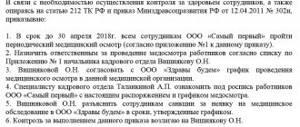The end of 2021 and the first half of 2021 were spent updating the Order of the Ministry of Health and Social Development of Russia dated April 12, 2011 No. 302n (hereinafter referred to as Order 302n). Konstantin Kirillov reviewed all the amendments to this legal act, understood their effectiveness and studied the draft of a “new” document on medical examinations.
All employers, in one way or another, were faced with the need to conduct mandatory preliminary and periodic medical examinations in their organizations. In accordance with Article 46 of the Federal Law of November 21, 2011 N 323-FZ “On the fundamentals of protecting the health of citizens in the Russian Federation,” a medical examination is a set of medical interventions aimed at identifying pathological conditions, diseases and risk factors for their development.
In relation to the employee, the following purposes of undergoing preliminary and periodic medical examinations can be distinguished:
- Determination of health status eligibility
- Dynamic monitoring of health status
- Timely identification of the negative impact of harmful and (or) hazardous production factors (hereinafter referred to as VOPF)
- Timely detection of occupational diseases
- Identification of medical contraindications to performing certain types of work
- Timely detection and prevention of the occurrence and spread of infectious and parasitic diseases
- Timely implementation of preventive and rehabilitation measures to preserve health and restore working capacity
- Formation of risk groups for the development of diseases that interfere with work performance
- Accident prevention
Regulatory framework for medical examinations
The regulatory framework on the issue of undergoing medical examinations is Article 213 of the Labor Code of the Russian Federation, which approved the need for certain categories of workers to undergo them, and Order 302n, which summarized the conditions and procedure for their implementation. This Order is a document consisting of three Appendices:
- List of VOPFs, in the presence of which you should undergo medical examinations (hereinafter referred to as Appendix No. 1)
- List of works during which medical examinations are carried out (hereinafter referred to as Appendix No. 2)
- The procedure for conducting medical examinations (hereinafter referred to as Appendix No. 3)
In 2019-first half of 2021. Significant changes were made to Order 302n three times:
- by order of the Russian Ministry of Health of December 13, 2021 N 1032n
- by joint order of the Ministry of Labor of Russia and the Ministry of Health of Russia dated April 3, 2021 N 187n/268n
- by order of the Russian Ministry of Health of May 18, 2021 N 455n
Who sends for periodic medical examination and how?
The referral procedure is strictly defined. Order of the Ministry of Health 302 n on medical examinations, as amended for 2021, prescribes such instructions. Employer:
- Compiles a list of employees, including the name of the type of work and the influencing factor.
- Approves the list of contingents subject to examination and sends it to the territorial agency of Rospotrebnadzor in the region of location.
- Sends a list of contingent and a list of employees by name to the medical institution that will conduct the procedure 2 months before it begins.
- Introduces employees to the calendar plan at least 10 days before they start.
- Provides a referral indicating the name of the employer, form of ownership and type of activity according to OKVED, name of the medical institution, type of examination, full name, position, type of work of the employee and influencing factors.
- Based on the results, a joint final act is drawn up.
Changes to Appendix No. 1 of Order 302n
One of the main questions when compiling a contingent of persons who are subject to medical examinations is “Is it necessary to undergo medical examinations if there are VOPFs at the workplace?” This was especially true for workers who work on personal computers (PCs).
At the end of 2021, the following changes were made to paragraph 3.2.2.4 of Appendix No. 1 of Order 302n:
Old version:
electromagnetic field of a broadband frequency spectrum from a PC (work on reading, entering information, work in dialogue mode for a total of at least 50% of the working time)
A new version:
electromagnetic field of a broadband frequency spectrum (5Hz-2kHz, 2kHz-400kHz) (if the maximum permissible level is exceeded)
From the new version it is clear that medical examinations using electromagnetic fields from a PC in a specified frequency spectrum are carried out only when the maximum permissible level is exceeded.
It is worth noting that this change is of a formal nature, because 2 footnote to Appendix No. 1 of Order 302n it has already been determined that the list of harmful factors includes factors that, according to the level of their impact, are classified as harmful and (or) dangerous classes,
in accordance with current regulatory legal acts, which is the Federal Law of December 28, 2013 No. 426-FZ “On special assessment of working conditions.”
But how to conduct studies of electromagnetic fields from PCs as part of a special assessment, taking into account footnote 5 to the Classifier of harmful and (or) dangerous production factors remains a mystery. Perhaps this is why the frequency ranges were clarified and the connection to the PC was excluded.
Responsibility of the employer and employee for permission to work without a medical examination
Existing legislation provides for liability for employers who do not comply with Order 302n as amended for 2021 and allow employees to work without undergoing a mandatory medical examination. Punishment for such an offense is provided for in Part 3 of Article 5.27.1 of the Code of Administrative Offenses of the Russian Federation. Under this provision, officials face a fine of 15,000 to 25,000 rubles. For persons carrying out entrepreneurial activities without forming a legal entity - from 15,000 to 25,000 rubles. Legal entities face a fine of 110,000 to 130,000 rubles. It is worth considering that the size of the fine depends on the number of people illegally admitted to work. If, due to evasion of a medical examination, an employee’s health is harmed or his death occurs, the employer’s actions are qualified in accordance with the provisions of the Criminal Code.
As for employees who refuse for any reason to undergo a medical examination, they must be suspended from work until they receive a conclusion confirming their suitability for work. Such liability is provided for in Article 76 of the Labor Code of the Russian Federation. We emphasize that the employee’s salary is not retained during the suspension, and he must be made aware of this fact.
Legal documents
- Federal Law of November 21, 2011 No. 323-FZ
- order 302 on undergoing medical examinations dated 04/12/2011
- Article 212
- 213 Labor Code
- 185
- 212
- 219 Labor Code of the Russian Federation
- Article 5.27.1 of the Code of Administrative Offenses of the Russian Federation
- Article 76 of the Labor Code of the Russian Federation
Changes in the composition of mandatory procedures and analyzes
In the new edition of Order 302n, footnote 3 to Appendix No. 1 and footnote 1 to Appendix No. 2 are excluded. They determined the range of mandatory procedures and tests during preliminary and periodic examinations of all subjects. Now, for this purpose, a separate paragraph 291 has been allocated in Appendix No. 3 and the range of mandatory procedures and analyzes has been significantly expanded.
When undergoing a medical examination, employees are now questioned to collect anamnesis, identify family history, complaints, and symptoms characteristic of certain diseases. Additionally, risk factors that increase the likelihood of developing chronic non-communicable diseases are identified. Among other things, body mass index is calculated based on measurements of height, body weight and waist circumference.
As before, a clinical analysis of blood and urine is carried out, the level of total cholesterol and glucose is determined, as well as fluorography or radiography of the lungs in two projections (direct and right lateral). All women are examined by an obstetrician-gynecologist with bacteriological and cytological examinations, and women over the age of 40 undergo mammography in two projections. Previously, this study was carried out once every 2 years, now - at every medical examination.
New types of research have also emerged for workers of different ages. For example, from the age of 18 it is necessary to measure blood pressure in the peripheral arteries, from 18 to 40 years the relative cardiovascular risk is determined, and at the age of over 40 years - the absolute cardiovascular risk. From age 40, intraocular pressure measurement is also required. The expansion of mandatory procedures was primarily aimed at obtaining a clearer picture of the health status of workers of different ages. But there is also a downside - additional financial costs for the employer due to the expansion of the research field.
Who undergoes treatment and which doctors
To conduct periodic medical examinations, the employer determines a list of employees (depending on the harmful factors affecting them and the type of work in which they are employed). Order 302n establishes the frequency of medical examinations by profession. The list for periodic medical examination includes employees:
- which are affected by harmful production factors from the list approved by the administrative document of the Ministry of Health;
- whose work activity is related to the list of types of work and professions provided for in the same document;
- related to transport (Article 213 of the Labor Code of the Russian Federation);
- workers in the food industry, catering and trade, medical and child care institutions, and water supply facilities (Article 213 of the Labor Code of the Russian Federation);
- athletes (Article 348.3 of the Labor Code of the Russian Federation);
- under 18 years of age (Article 266 of the Labor Code of the Russian Federation).
The Law on Medical Examinations determines the list of medical specialists and studies that are carried out during the periodic medical examination. They are established depending on the type of work included in the list by order 302n of the Ministry of Health, and on the influencing factors. The medical institution forms a medical commission chaired by an occupational pathologist with a valid certificate and approves the composition of the commission.
The list of medical workers who must examine the employee during a periodic medical examination under order 302n is given in the table.
| Type of impact | Doctors |
| Chemical |
|
| Biological |
|
| Physical |
|
| Labor |
|
Simplifying the procedure for undergoing medical examinations
In accordance with paragraph 61 of Appendix No. 3 of Order 302n, when conducting preliminary or periodic inspections, the following may be taken into account:
- Results of previously conducted preliminary or periodic inspections
- Medical examination results
- Other medical examinations confirmed by medical documents
The most important thing is that the results are no later than one year and that the employee has no symptoms of diseases indicating the presence of medical indications for undergoing a medical examination. Additionally, organizations conducting preliminary or periodic examinations may request from the medical organization at the employee’s place of residence or attachment all the necessary information to clarify the diagnosis.
Definitely, this change will have a positive impact on reducing the employer’s costs when undergoing medical examinations, especially in organizations with a high staff turnover or the presence of part-time employees.
Preliminary medical examination
This type of inspection is carried out when an employee is hired on the basis of a referral. This document is filled out based on the list of groups for which a medical examination is mandatory. Existing legislation does not provide for a unified form of referral. However, Order 302 for medical examinations contains a list of information that must be provided. Thus, each enterprise independently develops the form of this document. But in practice, employers try to use the forms used in medical institutions, since this allows them to avoid controversial issues.
The referral for a preliminary medical examination upon hiring (order 302n) must contain the following data:
- employer's name;
- form of ownership and type of economic activity;
- name of the medical institution, its address and OGRN code;
- type of inspection;
- FULL NAME. employee;
- Date of Birth;
- name of the structural unit and position;
- hazardous factors and types of work that the employee will encounter;
- FULL NAME. and the signature of the person responsible for issuing the referral;
- employee signature;
- FULL NAME. employee responsible for recording issued referrals.
To correctly draw up a referral for a medical examination in accordance with Order of the Ministry of Health and Social Development 302n dated April 12, 2011, study the example.
After receiving this document, the candidate for the vacancy is sent to a medical institution, where he provides a referral, passport, SNILS and, if necessary, a psychiatric report. Then a medical card and a health passport are created for the employee, where the conclusions of specialists are entered.
As a result, no later than 5 working days, the citizen is issued a conclusion, which indicates the result of the inspection: whether any contraindications for carrying out a specific type of activity have been identified. This document is now compiled in four copies:
- one is attached to the medical record of the medical organization where the examination was carried out;
- the second is issued to the employee;
- the third is sent to the employer;
- the fourth - to the clinic to which the employee is attached (with his consent).
Documents for medical examination
The composition of the documents that must be submitted by an employee to a medical organization when undergoing a medical examination has changed. Now, in addition to the previously usual referral, passport (or other identification document) and psychiatric examination (for some categories of workers), SNILS has been added.
To simplify the procedure for undergoing a medical examination, an employee entering work can provide an extract from the medical record at the place of residence or attachment with the results of the medical examination.
Deadlines for medical examinations
As before, medical examinations must be carried out no less frequently than the periods specified in Appendix No. 1 and 2 to Order No. 302n. However, now, in accordance with changes to paragraph 16 of Appendix No. 3, the Employer can postpone the medical examination for a period of no more than 6 months if a high alert or emergency situation is introduced in accordance with Federal Law of December 21, 1994 N 68-FZ “ On the protection of the population and territories from natural and man-made emergencies.”
This change came into force on June 2, 2020 and was quite expected due to the spread of coronavirus infection (COVID-19) and the self-isolation regime introduced in the Russian Federation.
Types of medical examinations
Article 46 of the Federal Law of November 21, 2011 No. 323-FZ identifies the following types of inspections:
- preventive – aimed at early detection of dangerous diseases and conditions;
- preliminary - carried out upon hiring;
- periodic - carried out at enterprises during the periods established by regulations in order to identify and prevent occupational and other diseases;
- pre-shift or pre-trip - carried out immediately before the employee goes on shift;
- post-shift or post-trip - carried out at the end of the working day.
Periodic examinations at occupational pathology centers
Some categories of workers must undergo periodic medical examinations at occupational pathology centers (hereinafter referred to as centers). Let me remind you that these centers deal with issues related to protecting the health of workers and medical and social security for victims of industrial accidents and occupational diseases. In this connection, paragraph 37 of Appendix No. 3 to Order 302n determined the categories of workers who are required to undergo examinations at occupational pathology centers, their frequency and other requirements.
In the old version of Order 302n, this paragraph defined only general requirements for employees and the frequency of inspection. In the new one, some features have been additionally adjusted. For example, in the regions of the Far North and equivalent areas, as well as in the absence of an occupational pathology center in the locality in which the work is carried out, periodic examinations of workers with 5 years of work experience or more can be carried out not in a hospital setting, using mobile medical complexes.
But before this, workers must undergo appropriate diagnostic tests in medical organizations. And after conducting a periodic examination in a “mobile” center, the employee presents an extract from the medical record, which reflects the conclusions of medical specialists, research results, as well as conclusions based on the results of a preliminary or periodic examination for previous years of work in harmful and (or) dangerous working conditions. At the same time, during the year of the “mobile” examination, a periodic examination in another medical organization is not required.
Additionally, upon written request and if the employee agrees, the results of a periodic examination by the occupational pathology center are transferred to the Social Insurance Fund.
The changes made may solve problems associated with the peculiarities of undergoing medical examinations of certain categories of workers, and may also make it possible to reduce some financial costs associated with employee travel to inpatient occupational pathology centers.
However, there is another side - where to get “mobile” occupational pathology centers and at whose expense they will be “organized” in those very regions of the Far North.
When and why are periodic medical examinations performed?
Establishes what is included in the periodic medical examination of workers, Order of the Ministry of Health 302n. The list depends on working conditions; examination by doctors is provided:
- ENT;
- dermatovenerologist;
- neurologist;
- surgeon;
- ophthalmologist;
- dentist;
- urologist;
- oncologist;
- allergist.
The goal is to check for the following risks:
- Chemical (those whose contents are measured in the air of the employee’s place of work and on his skin), including elements of a biological nature derived through chemical synthesis - antibiotics, vitamins.
- Biological (pathogens, spores, microorganisms with pathogenic properties).
- Physical (ionizing and non-ionizing radiation, vibration, noise, high or low ambient temperature).
- The severity of the work process (static and dynamic load, posture during work, weight of loads).
- The intensity of the work process (the degree of load on the senses, voice, the degree of density of sound and light signals).
The timing of the procedure depends on what harmful factor is involved and the degree of its danger. The deadlines under Order 302n are determined at least once every two years, for some influencing factors and types of activities - at least once a year. Workers under 21 years old, according to order 302n, undergo periodic examinations every year. The Occupational Pathology Center carries out periodic procedures at least once every 5 years.
Periodic medical examinations according to order 302n are necessary for:
- monitoring the dynamics of employee health, detecting occupational diseases at the initial stage and the degree of influence of harmful factors;
- detection of not only diseases and conditions that prevent the continuation of a certain type of work, but also work, the implementation of which requires monitoring of health status;
- timely development of a list of health-preserving preventive and rehabilitation measures;
- prevention of the emergence and spread of infectious and parasitic diseases;
- preventing accidents at the enterprise.
Results of medical examinations
In accordance with the new edition of paragraph 46 of Appendix No. 3 of Order 302n, upon completion of the examination, medical organizations must perform the following actions:
- Provide the employee with an extract from the medical record with the conclusions of medical specialists, research results, the final conclusion, as well as recommendations for the prevention of identified diseases, including occupational ones, and, if there are medical indications, for further observation, treatment and medical rehabilitation
- Send a copy of the extract to the medical organizations at the employee’s place of residence or attachment, subject to the employee’s written consent
Summing up
With the amendments to Order 302n having entered into force, I would like to note the possibility of reducing the Employer’s financial costs by using the results of medical examinations that were carried out previously. Not least important was the expansion of the range of mandatory tests and procedures, as well as the possibility of transferring examination results to the medical organization at the place of attachment, which will provide a more complete picture of the employee’s health status. The employer must review the internal documents of the organization,, if necessary, make adjustments to the contingent of people undergoing medical examinations, and also work out the possibility of optimizing costs at their enterprise.
At the moment, the “new” 302n Order with the following changes is being considered on the Federal Portal of Draft Regulatory Legal Acts:
- There is no indication of the frequency of medical examinations
- There are no indications on the nomenclature of medical specialists, types of laboratory tests and additional medical contraindications
- Medical examinations according to the list of production factors are carried out (with some exceptions) depending on the established KUT
- Added indicators on the intensity of the labor process
- Decree personnel, medical personnel and teachers are excluded from the types of work for which it is necessary to undergo medical examinations
- The procedure for conducting medical examinations has been excluded, but the “old” procedure set out in Appendix No. 3 to Order No. 302n will remain in force
We can only believe that the division of the existing Order 302n into two documents will not be a formal procedure, but will bring some positive significant changes to the procedures for organizing and passing medical examinations.
Otherwise, this goes against the principles of the “regulatory guillotine” about removing the excessive administrative burden from entrepreneurship. Read the material in the source
Results
- Taking into account the changes in the Order, it is necessary to review or make adjustments to the contingent lists.
- If the enterprise has regulatory documentation on conducting medical examinations, it must be brought into compliance with current legislation (taking into account all changes).
- When determining the risk of developing occupational diseases of employees, medical examination data can be taken into account. This will allow you to optimize the management of freebies in the SOUT.
- It is necessary to inform employees that in order to undergo medical examinations they need to have their SNILS with them and, if available, the results of other medical studies.
- When calculating the cost of medical examinations, it is necessary to take into account the possibility of offsetting the costs of the examinations specified in clause 9.1 of Appendix 3, taking into account the data provided by the employee from the results of other medical examinations.








